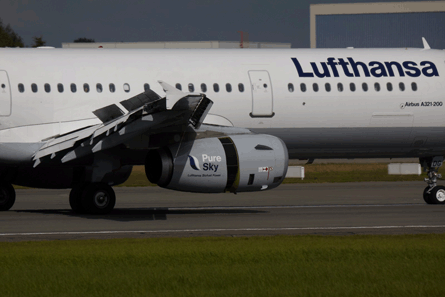Recent rush of airline biofuel flights illustrates growing momentum, but ramping up remains key challenge ahead
Moves to push forward the use of biofuels in the airline sector gained fresh pace with a flurry of operators carrying out or announcing plans for regular or test commercial flights.
After KLM operated the first scheduled passenger biofuel flight at the end of June, Lufthansa subsequently became the first to launch regular commercial service powered by biofuel. In July it begun six months of flying an Airbus A321 four times daily on its Frankfurt-Hamburg route, using a 25% blend of biofuel based on jatropha, camelina and animal fat.
Finnair and Mexican carriers Aeromexico and Interjet have all also recently carried out commerical biofuel flights, while UK leisure carrier Thompson Airways will operate a Boeing 757 between Birmingham and Palma powered by a 50:50 blend of biofuel derived from used cooking oil and kerosene from September.
|
|---|
©R.Hesse |
While the marketing value to airlines of improving their green image with biofuel test flights and services is evident, how airlines develop their biofuel strategies beyond this stage is less clear.
Deirdre Kotze, airline environmental manager for Thomson Airways, says that as well as boosting environmental credentials, biofuel flights are important for gathering data and "sending a strong signal to the investment community that there is a market for sustainable biofuel".
Terrance Scott of Boeing's biofuels strategy team describes the current situation as "chicken and egg". He says with demand for biofuels exceeding supply, "the next step will be for the same focus to be applied to improving the supply chain that was made to developing the technology". However, Scott says to achieve this, the farming and processing communities must first be convinced of the market for biofuels.
"We set a target as an industry of getting to 1% [of all aviation fuel used being biofuels] by 2015, that's roughly about 600 million gallons," he says. Although Scott concedes that this is a fairly conservative target, he adds: "The first 1% is the hardest if we can get 1%, then we can figure out how to get to 5, 10, 20%."
Kotze agrees that the improvement of the supply chain and the associated decrease in cost is the most pressing issue to enable biofuel use to become more widespread. "It will require a significant amount of investment before it becomes commercially viable for us. One of the reasons we're doing a relatively small purchase is because of the price and in addition there isn't actually that much available," Kotze says.
She adds: "Between the four leading airlines [involved in biofuel flights], we've probably procured a large proportion of what is commercially available at the moment". Kotze saysthe biofuels supply chain requires new refineries in better locations.
Given that much of the required help and supply chain investment must come from governments and banks, this is unlikely to happen soon, says Simon Powell, head of Asian oil and gas research and former head of sustainable research for investment firm CLSA.
With regards to legislative help for green initiatives such as biofuels, he says: "Given where the world's financial markets [are] and where the world's economy is, way down on people's agenda is forming any agreement on limiting CO2 emissions, which would ultimately mean higher prices for consumers." Powell also says that old-fashioned environmental prejudices against the aviation industry hinder investment from fund managers managing green funds.
He believes biofuels production will be driven by oil prices. "You could imagine at the end of 1Q 2011 when Brent [crude] was $120 a barrel, the pressure to produce much more biofuel was definitely there. But if Brent has fallen below $100 in a short space of time and finishes the year with an 8 in front of it, then the pressure from CEOs and boards diminishes," he explains.
However, the European Union Emissions Trading Scheme (EU ETS) could prove to be a driver of the use of biofuels, according to Powell. He says that potentially "if airlines switch to a higher amount of biofuels, then they can minimise the bill that they ultimately have to pay to the European Union."
Yet even with this, Powell feels the next significant developments in energy efficiency and emission reduction will come from improvements in aircraft design.
Boeing's biofuels strategy team is more optimistic about how soon widespread biofuels adoption could become reality and states that biofuel use and development is ahead of where many industry observers believed it currently would be.
Much of the portion of the company's $4 billion research and development budget that is dedicated to biofuels research is focused on algae. Widely tipped to be the biofuel with the most potential for aviation, it avoids all of the controversies associated with earlier generations of biofuels as it is not grown in areas that could be used for food production.
Scott says five to eight years is a conservative estimate of when algae biofuel will be commercially available and he believes that "algae, because of its reproductive capability over the long term, has the potential to provide all of aviation's fuel needs".
Join the debate over the future of aircraft fuels or read the latest developments online at flightglobal.com/environment
Source: Airline Business
























